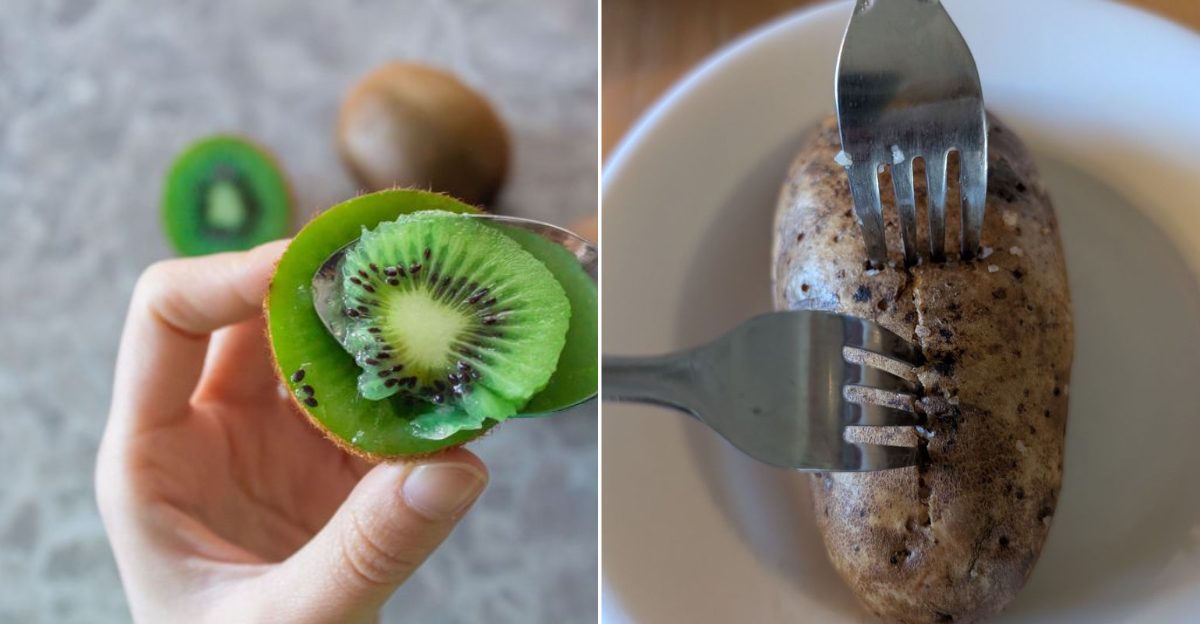20 Common Foods You’ve Probably Been Eating All Wrong

You might think you’ve mastered the art of eating, but some of your favorite foods have secret rules you’ve been ignoring.
From the way you peel a banana to how you scoop peanut butter, small tweaks can make a big difference in flavor, texture, and even mess.
It’s not about being fancy, just smarter with your bites. Get ready to unlearn a few habits and discover easier, tastier ways to enjoy the foods you thought you knew.
1. Banana Blunders
Monkeys have it right! They open bananas from the bottom, not the stem. Pinch the dark tip and peel downward to avoid those stringy bits that cling to the fruit.
The stem actually serves as a perfect handle while you eat. Plus, opening from the bottom eliminates the frustration of dealing with stubborn stems that refuse to snap correctly.
2. Avocado Accidents
Slicing into the pit is asking for an ER visit! Cut around the avocado lengthwise, twist the halves apart, then remove the pit by gently tapping a knife into it and twisting.
For perfect slices, leave the skin on and score the flesh in a grid pattern. Then simply scoop out with a spoon for beautiful, ready-to-use pieces without the slippery mess.
3. Kiwi Confusion
Fuzzy kiwi skin is actually edible and packed with nutrients! Simply wash the fruit thoroughly and bite right in. The contrast between fuzzy exterior and juicy interior creates an interesting texture experience.
Not convinced? Try cutting it in half and scooping with a spoon. Or my favorite hack: slice off both ends and use a spoon to separate the skin from the fruit in one smooth motion.
4. Pineapple Predicaments
Rolling a pineapple on the counter before cutting helps break down the fibers, making it juicier and easier to eat. After cutting off the top and bottom, stand it upright and slice downward to remove the skin.
Want to skip the coring hassle? Pull apart the fruit using the natural sections! Cut into rings, then grab a section and pull. The segments separate naturally like flower petals.
5. Corn on the Cob Catastrophes
Horizontal munching leads to kernels everywhere! Try eating corn vertically, row by row. This method is cleaner and gets more corn in your mouth instead of stuck in your teeth.
Another game-changer: place an ear of corn in the center hole of a Bundt pan. As you cut downward, the kernels fall neatly into the pan instead of scattering across your counter.
6. Potato Problems
Microwaving potatoes without poking holes? That’s a recipe for a spud explosion! Prick your potato several times with a fork before cooking to allow steam to escape.
For the fluffiest baked potatoes, try this trick: after poking holes, rub with oil and salt, then bake directly on the oven rack. When nearly done, give it a firm smack to fluff up the insides!
7. Tomato Troubles
Storing tomatoes in the fridge ruins their flavor and texture! Keep them at room temperature, stem-side down to preserve freshness longer.
When slicing tomatoes, use a serrated knife instead of a straight-edged one. The tiny teeth grip the skin without squishing the juicy insides.
For cherry tomatoes, place them between two plastic lids and slice through the middle in one swift motion.
8. Apple Approaches
Eating apples from the top down wastes the best part! Start from the bottom and eat upward. You’ll consume the entire fruit, core and all.
The seeds are easily avoided, and the stem makes a perfect handle. Not ready to eat the core?
Try cutting the apple horizontally instead of vertically. This reveals a beautiful star pattern in the center and gives you perfect rings that won’t brown as quickly.
9. Strawberry Slip-ups
Hulling strawberries with a knife wastes precious fruit! Push a straw through the bottom and up through the top to remove the stem and leaves in one clean motion.
Want perfectly sliced berries? Use an egg slicer! Place the strawberry in the slicer and press down for uniform pieces perfect for salads or desserts. This works for other soft fruits like kiwis and bananas too.
10. Egg Errors
Cracking eggs on the rim of a bowl creates shell fragments that fall into your mixture. Tap them on a flat surface instead. This creates a cleaner break with fewer shell pieces.
Hard-boiled eggs giving you trouble? Add a teaspoon of baking soda to the water before boiling.
The shells will practically slide off! For perfect peeling, crack and roll the egg on the counter before peeling under cold running water.
11. Pasta Pitfalls
Breaking spaghetti before cooking is a cardinal sin in Italian kitchens! Instead, place one end in boiling water and as it softens, gently push the rest in.
The pasta will fit perfectly without sacrificing texture. Always save some pasta water before draining.
This starchy liquid is liquid gold for creating silky sauces that cling to your pasta. Just add a splash when mixing sauce and pasta together.
12. Rice Riddles
Rinsing rice isn’t just an optional step. It’s essential for removing excess starch that makes your rice sticky and gummy. Rinse until the water runs clear for fluffier results.
The finger measurement trick works across cultures! Add rice to the pot, then add water until it reaches the first joint of your index finger when touching the rice surface. This works regardless of rice quantity or pot size.
13. Chocolate Challenges
Storing chocolate in the fridge creates condensation when you take it out, which leads to sugar bloom. Those white spots that affect texture and taste. Keep it in a cool, dry place instead, ideally between 65-70°F.
For perfect melting, chop chocolate into uniform pieces and use a double boiler instead of direct heat. Adding a tiny bit of coconut oil helps create smoother melted chocolate for dipping.
14. Shrimp Stumbles
Peeling shrimp one by one is tedious! Grasp all legs and pull them off in one motion, then pinch the tail while pulling the meat out.
The shell comes off cleanly without wasting any delicious meat. Leaving the tails on while cooking adds flavor, but creates messy eating.
For dinner parties, remove all shells but leave the last tail segment for an elegant handle. Your guests will appreciate not having to get their hands dirty!
15. Cereal Setbacks
Pouring milk first is actually better! Adding cereal to milk prevents immediate sogginess and lets you control exactly how much cereal gets wet at once.
Add small batches as you eat for maximum crispness throughout. Warm milk with cereal helps release more flavor compounds.
Try heating your milk slightly before adding cereal, especially with cinnamon or chocolate varieties. The enhanced aroma creates a completely different breakfast experience.
16. Mango Mistakes
Slicing mangoes can be a sticky disaster! The hedgehog method works wonders: cut along both sides of the pit, score the flesh in a grid pattern without cutting through the skin, then invert the half to expose perfect cubes for easy eating.
For mangoes that are still a bit firm, roll them firmly on the counter before cutting. This breaks down the fibers inside, making the fruit juicier and easier to separate from the pit.
17. Watermelon Woes
Cutting watermelon into triangles creates messy hands and juice-covered faces! Try cutting it into sticks instead, like french fries.
These neat portions are easier to hold and perfect for dipping in salt or tajin.
Look for a yellow spot where it sat on the ground, the darker yellow, the riper the melon. The skin should also have a matte finish rather than shiny.
18. Garlic Gaffes
Mincing garlic with a knife is slow and inefficient. Smash the clove with the flat side of your knife first – the skin slips right off and the garlic becomes easier to chop.
For multiple cloves, try the shake method: separate cloves, place in a metal bowl, cover with another bowl, and shake vigorously.
The skins separate like magic! For mincing, a microplane creates perfect garlic paste in seconds.
19. Onion Oversights
Crying while cutting onions? Chill them in the freezer for 10-15 minutes beforehand! Cold temperatures slow down the release of the tear-inducing compounds that make your eyes water.
For perfect diced onions, leave the root end intact while cutting. Make horizontal cuts, then vertical cuts, and finally chop across.
This technique keeps the onion together during cutting and creates uniform pieces that cook evenly.
20. Bread Blunders
Storing bread in the refrigerator actually makes it go stale faster! The cool temperature accelerates the recrystallization of starch molecules.
Keep bread at room temperature in a bread box or paper bag for best freshness. When slicing fresh bread, flip it onto its side.
This creates less compression and gives you neater slices. Using a serrated knife with a gentle sawing motion prevents squishing your beautiful loaf into a flat disappointment.
